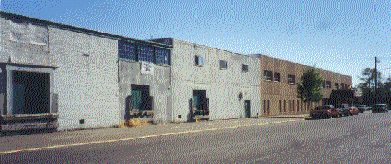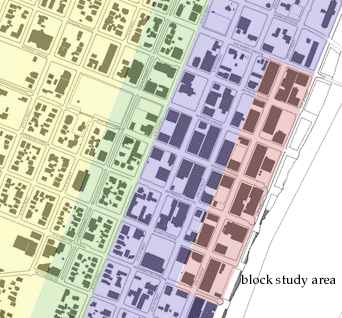| Architecture Studio 281 | |||||||||
| Connection
to Other Neighborhoods
|
Commercial vs. Residential |
||||||||
| Light Commercial (small businesses) | |
| Heavy Commercial (large businesses) | |
| Transition from Commercial to Residential | |
| Residential |
The transition is quick from commercial to residential buildings. Each new street brings changes from the last. Within one block of Washington Avenue, on 2nd street, the buildings loose the feeling of welcome that 2nd Street provides. The buildings begin to show hard, drab, cold surfaces to the street.

One block over from 2nd Street the buildings change to larger commercial
buildings, most of which are designed to be simple cubes. Larger
companies such as grocery stores, insurance agencies, gas stations, and
diners occupy these cubes. The character of the street is changed
by the lack of awnings and large store front windows to draw the customer
in. 4th Street and 5th Street continue in this design. 6th
Street brings the addition of residential buildings to the area. Within
this block the combination of commercial and residential buildings can
be seen from one side of Washington and 6th, where a family house occupies
the lot, to the liquor store built across the street. 
From the corner of 7th and Washington on towards OSU residential buildings
occupy the area. Although some small businesses have moved into these
houses, the character of the streets reflect the family and/or college
life of the occupants.
Street With/ Parking
One characteristic that defines the change from one street to the next is the width of each street. This dimension is important in understanding the role each street plays in the town. Within the 6th blocks of the study, 2nd Street is a small one-way road, with two lanes, and angled parking. The combination of these aspects contribute to the quaint feeling of 2nd Street by bringing the scale of the street down. It provides a safe and comfortable atmosphere. The larger width of 4th Street acts simply to get people to and from the larger businesses that occupy this area. With the addition of only one lane, the three lanes of traffic gives a sense of urgency that 2nd Street lacks. The street becomes intimidating to a person as the scale of the streetscape is brought to a larger size. Then again as the blocks make a transition from commercial to residential buildings the scale comes down again. The feeling of the neighborhood is inviting with unmarked two way traffic.
2nd Street
4th Street
7th Street
Landscape
In addition to the width of a street, landscaping contributes to the scale and thus the character of a street. The planting of trees on 2nd street has an organization to it. Each tree has it's own square cut from the pavement. The thought put into the plans shows care for the street which then provides a sense of welcome to the customer. The height of the trees creates a pleasant space underneath as well. The lack of trees on 4th street and in general around the larger commercial area adds to the cold and therefore uninviting feeling of this area. The streets have no landscape plan giving it an uncomfortable scale and making it a place for in and out shopping. Once again with the transition into the residential area brings the planting of more trees. Although these plantings are not planned the density of the trees brings the scale down . A person can feel at ease walking through the neighborhood.Architecture and Allied Arts, The University of Oregon1999
